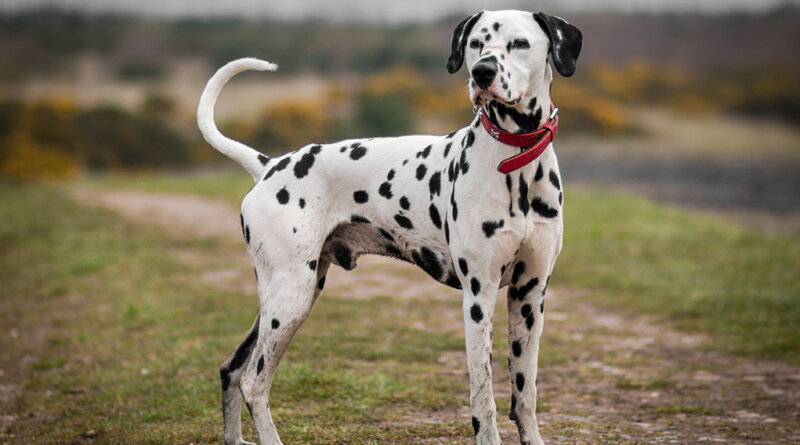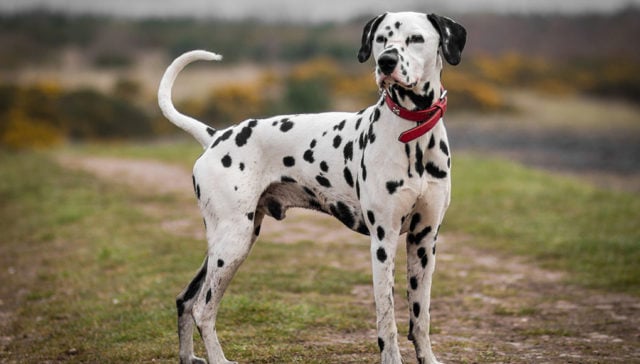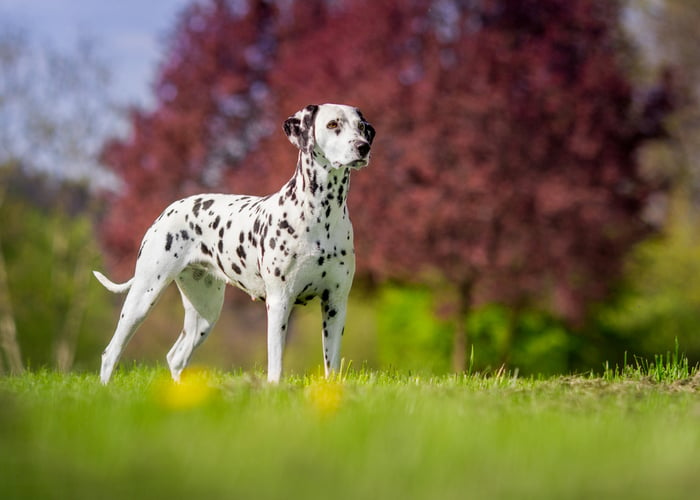Dalmatian Dog Breed Profile – Top Dog Tips
One of the most recognizable breeds in the world is the Dalmatian Dog Breed. I’m sure you’re familiar with Disney’s 101 Dalmatian and recently Cruella.
No one can ever resist the dalmatian puppies there which are so adorable!
The superstars of the film were the cruel Cruella and the non-other than the Dalmatians. Just like Cruella, we are bound to fall in love with these spots of wonder.
This breed is a magnificent worker of wonder! Imagine how their breed has been with us humans for so long yet their breed’s origin remains a mystery.
This breed is extremely historic. Coming from the age of Egyptian tombs, Geek frescos, and chariots, this breed has marked its existence along with humans. Their existence is carved in tombs and paintings.
Historians suggest that breeding a Cretan Hound and a Bahakaa Dor or White Antelope Dog is the origin of the breed as well.
The offspring are well known to work alongside horses and hunt deers that may have begun the discovery of their ability.
Theories suggest that from this, their name came from the Latin and French term Damachien, which means follow deer and dog.
History of the Dalmatian Dog Breed
During the early 1800s, Dalmatians were found mostly in the region of Dalmatia in Central Europe. Yet there are hints of its origin from different continents as well from Asia, the British Isles, Europe, and North Africa.
Dalmatians are often seen with Romanis. They were prohibited from securing their land and had to travel to make a living.
The Romanis became nomads which made them travel place to another for ages. This breed accompanied Romani people during their travels in Europe and may be the reason their origin remains unknown until today.
Dalmatians are also significantly known as coach dogs. Working along beside horses, coaches, and humans, Dalmatians have rendered protection and assistance.
They are known to assist coachmen in guarding unmanned coaches, lead horses in the proper direction and avoid possible hurdles.
For some time, they are also found to be coach dogs for British nobles. With their strong yet poise appearance and manner, they were positioned to walk alongside these noble men for their aesthetic and athletic ability.
They also are capable of being pack dogs or shepherds sporting dogs. Dalmatians have worked with humans through the war as messengers as well.
Until then, they began working alongside firefighters. Dalmatians were natural as coachers. They were able to keep up with the firefighters’ rush and brisk movement.
Dalmations were assisting firefighters with warning pedestrians, guarding and calming down horses while the firefighters do their work.
Even though the modern age, dalmatians adapted from horses to trucks. Although they do not coach the trucks, they sit beside firefighters and help warn civilians in the area of accidents.
Let’s take a look at what a standard Dalmatian looks like.
Physical Characteristics
Their distinct appearance is undeniably recognizable. The white coat and black spots.
Dalmatians are often found white with black spots but they can also come with liver brown spots.
Dalmatians are poised and muscular. They stand between 19 to 23 inches in height and their body is fit but free from loose skin.
A dalmatian’s eyes are usually blue or brown. It should be proportionate with the face shape. They usually have a strong expression. Their eyes look alert but patient.
Dalmatian ears are moderate in size, it flops down with a rounded tip. Their skull is flat at the top and the muzzle extends smoothly, giving it a slim look. Their nose usually comes in black or liver brown color as well.
The body connects quite smoothly, since Dalmatians are fit, their body emphasizes the smoothness of their body.
From a fairly long neck, deep chest and rib area springs smoothly to their stomach, and their slim legs and tail give a smooth curve appearance.
Strangely, dalmatian puppies are born without their spots being visible at all. They start developing their spots when they grow older.
Marvelously, just like a snowflake, no dalmatian has the same spots. Usually, their spots begin appearing at two weeks of age.
Dalmatian Dog Breed Temperament
Dalmatians are natural social butterflies where they live through interactions both with humans and their surroundings. They are very outgoing.
From working with coaches, travelers, firefighters, and circus, they have been exposed to a variety of ventures and people.
Dalmatians are quite extroverted. They can communicate openly to their owners or family regarding what they are feeling.
It’s not that they’re vocal but through zealous changes in behavior and constant demand for attention.
Dalmatians are very easygoing when it comes to humans. They can quickly build relationships with them as well.
Although they are great around children, it’s still best to accompany them when they’re around children.
Their energy level is quite high and may not be able to contain their excitement when interacting with children.
Dalmatians are known for being highly energetic and intelligent. Stimulating them daily with a variety of exercises and activities is a must. They rely much on their owner’s leadership and company.
Dalmatians can be sensitive to new things but they can adapt as easily as well.
As an owner, displaying calmness and assurance can help them stay relaxed in new situations. The great thing about Dalmatians is that they’re undemanding adaptable.
They have a moderate barking level. They’re not very alert to anything that passes by.
Sometimes they will bark at something specific but if they recognize it as not harmful or reactive, they’ll likely ignore it for a while.
The Sociability of a Dalmatian
The Dalmatian dog breed does well with strangers. They are particularly vigilant around strangers when they pose danger to their owner or family.
Of course, it is their instinct to step up during these situations. Getting their attention, reassuring security, and displaying safety would help them calm down and recognize the situation better.
They are also great around other dogs. Yet it’s best to have them supervised when in contact with other dogs.
Some dogs may express sudden outbursts of aggressiveness which may trigger a Dalmatian’s guarding instincts.
When Dalmatians are not exposed to other animals at a young age, they may become aggressive or twitchy with their first encounter.
So it’s important to keep in mind exposing them to other animals as well, not just humans.
Training a Dalmatian
Dalmations are highly trainable. Their working breed requires a lot of discipline and training.
But, training a Dalmatian isn’t easy if you aren’t experienced. Commands and tricks are to be dealt with firmness and strictness.
The tricky part is that Dalmatian training requires positive reinforcement for better response to commands. They do not respond well to reprimands instead they tend to sulk after.
Dalmatians are extremely intelligent using physical and mental pursuits. Along with their significant amount of energy and intelligence, their memory is very keen toward the treatment of others towards them.
Dalmatians have a significant amount of energy which is perfect for training. If they deem their energy isn’t being released. They will tend to be restless and pursue their diversion.
Exercising a Dalmatian
Exercising more than an hour a day will keep them satisfied. Of course, adding other short activities can also keep them stimulated for the day.
The best thing to do is to give them a variety of activities, toys, or bonding time at them intervals during the day.
It may be short but distributed throughout the day. Such as daily runs or walks can help keep them happy. If they will be introduced to other activities, it is better as well.
Exposure is vital to Dalmatians at a young age. Introducing them to different surroundings, people, animals, objects, and situations can help develop their cognition and awareness better.
It’s essential to introduce them to different things for the first few months of their age but intense activities should be introduced at least when they’re two years of age.
Since their bones, joints, and muscles aren’t fully developed, it is best to introduce these activities steadily.
Through this exposure, they’ll be able to develop, adapt and assimilate manners.
Training Dalmatians require experience and firmness. Remember these are highly intelligent creatures that equal their energy levels.
Keeping them stimulated physically and mentally is a must. Being able to control them might be difficult when they’re older and it would require a great amount of patience but is worth it.
Dalmatian Dog Breed Health Care
This breed has become extremely popular due to the film and its utility capability, breeding them incorrectly has been substantial.
Dalmatians that are bred overlooking genetically inherited diseases and disorders have become more prominent in the years.
Dalmatians are prone to:
- Congenital Diseases
- Dental Disease
- Hip Dysplasia
- Inherited Deafness
- Optic Diseases
- Urolithiasis
It’s important to get your Dalmatians from licensed breeders. Some breeders have their dalmatians studded without having it consulted with a veterinarian for diseases or disorders that can be inherited.
Bone and joint problems can be a problem with Dalmatians too. Since Dalmatians develop their bones and joints rapidly, some may experience osteochondritis or hip dysplasia.
These complications are very painful. It’s important to determine when not to expose them to a certain activity.
Their diet is also the key here. Keeping them out of the obese and overweight category may lessen the tendency for them to acquire the disease.
Dental health can also be a complication with Dalmatians, especially in elderly dogs.
Having their teeth check-ups as well is essential. Overbite or underbite can be treated.
All Dalmatians can inherit the deafness. Not all Dalmatians that inherited it will be completely deaf.
Some are born with the other ear and are still able to hear but should still be checked up regularly to keep it from getting other complications.
Dalmatians are prone to urolithiases, it is the formation of urinary stones. Uric acid builds up salt and grows into larger stones that make it difficult for the dog to urinate.
RECOMMENDED: Dalmatian Puppy with Deadly Disease Purchased Online Gets a Second Chance with New Mom
Dalmatian Diet
Dalmatians must watch out for calories. Giving them an adequate amount is good but should be given in intervals.
Excessive amounts of liver and beef can cause urate stones, so it’s best to give it sparingly.
During training, we should be careful with the number of treats given as well. Too many treats can affect a Dalmatian’s weight swiftly.
Table food is best not given to them as well, if so, a very small amount is passable.
Feeding them 2 cups of food in two or three meals a day is enough. Mixing dry food and wet food is good since wet food promotes hydration as well.
Accessible fresh water is always important. This can keep them hydrated and their urine diluted.
Grooming
They do not need frequent grooming. Giving them casual baths or after activities that exposed them to dirt are enough to keep their coats clean.
Dalmatians have their distinct color. They are known for their white coat and black patches. This coat is short and smooth.
Surprisingly even when dalmatians are short-haired, they have a high level of shedding. They shed daily but only excessively twice a year as well.
Brushing their coat two to three times a week can help maintain their coat health and stay in shape.
A horsehair mitt or rubber curry comb is recommended to be used in getting rid of dead hair while grooming.
Since Dalmatians have ears flopped down, it’s best to have them checked regularly for infections and keep them dry after a bath.
Their nails can be trimmed monthly and filed weekly.
Dalmatians are less likely to drool as well. It’s not necessary to wipe their mouth frequently but they are prone to dental complications.
It’s best to have their teeth cleaned regularly and checked with the veterinarian as well.
Commonly Asked Questions aBOUT the Dalmation Dog Breed
Is Dalmatian a good family dog?
Yes. Dalmatians are known for their loyalty and companionship with humans. But since they are a ball of energy, it’s best to have them supervised when they’re around children.
Children are high in energy as well, and that makes Dalmatians very excited and may accidentally harm the child with playtime.
However, it is unlikely. Just to make sure, it’s still best to keep them accompanied.
Are Dalmatians dumb?
No. Dalmatians are one of the smartest dogs. They’re utility dogs and can learn to work with humans easily.
Training them at an early age is the trick. Exposing them to different activities at a young age helps them learn things faster.
Is Dalmatian a good first dog?
Veterinarians may suggest getting a different breed. Dalmatians require leadership, experience, and an extensive exercise regimen.
If the person is willing to exert much effort, then researching a bit more and deciding carefully may help them in adopting a Dalmatian.
Dalmatian Dog Breed: Final Thoughts
The Dalmatian dog breed isn’t just about its spots. They are very talented and intelligent and they have been around us since ancient times.
Their loyalty, dedication, and mutual trust have brought happiness and convenience to us.
Indeed, they are remarkable but let us be reminded. Adopting and owning a dog, moreover, an adult or disabled one is a huge responsibility.
We as owners are to be accountable for any harm, complication, or problems that may come our way.
But if you’re the type to travel a lot, along with your dog, and get them out for exercise daily, it would be fine.
They can be left alone for a few hours but it’s highly suggested to have them dog-sit or boarded instead.
If you’re the type to be gone for long periods of hours, adopting Dalmatian puppies is not the best for you and the dog.
They require extensive amounts of space, exercise, and attention. If you feel you are not able to exert these needs, it’s best to look for other options.
Dalmatians are made to work with us, let us utilize their ability and reward them with a giving and loving home.
This breed will extend its efforts for your protection, convenience, and laughter.
If you’re considering getting an older dalmatian or deaf dalmatian, it’s best to do research or ask a veterinarian what requirements or details you should look out for.
READ NEXT: 4 Most Popular Large Shorthaired Dog Breeds That Are Easy to Groom
Related









super kamagra https://kamagra.icu/# – sildenafil oral jelly 100mg kamagra